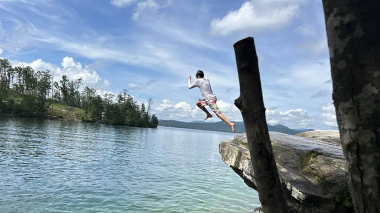 By Dr. Andrew C. Herman, chief medical officer of Atrium Health’s Levine Children’s Hospital
By Dr. Andrew C. Herman, chief medical officer of Atrium Health’s Levine Children’s Hospital
Above and beyond, our communities, our healthcare workers and our loved ones will get through this pandemic, this will get better. But in the meantime, we need to protect our vulnerable populations, including children.
An Evolving Situation
On February 11, the World Health Organization announced that the disease causing the 2019 novel (or new) coronavirus outbreak (abbreviated as COVID-19) was first identified in Wuhan, China. Since this is a new strain, we’re not exactly sure what to expect. The short history of this indicates that kids tend to be healthier, but what we don’t know yet because there has not been enough of those cases to study is how this disease might affect kids with significant chronic illness or the immunocompromised – something we commonly see here at Levine Children’s in the case of transplants or kids with cancer diagnoses.
Since numbers are still rising in the United States, the preventative measures we are taking are even more proactive in the hope that we can reduce the velocity of the spread.
Managing the Spread
Community spread is when people have been infected with the virus in an area, including some who are not sure how or where they became infected.
I believe that preventative measures being made now, however dramatic, will make the difference to reduce that threat. As healthcare workers, we have a coordinated approach from the CDC to try to reduce the spread. So, I absolutely am optimistic.
Since the velocity by which this is spreading across the world is unprecedented, it does have to be taken seriously. Many of the same measures we are using for the coronavirus we use every day to prevent transfer of all infections to other patients. The difference is the rapid spread of this disease and the challenges we may face with overwhelming our healthcare systems, if the spread is not contained.
How It Presents in Children: Symptoms and When to See a Doctor
The first two weeks, it typically presents like a cold. Fever, cough and shortness of breath may appear 2-14 days after exposure. More urgent symptoms might include:
- Difficulty breathing or shortness of breath
- Persistent pain or pressure in the chest
- Confusion or inability to arouse
- Bluish lips or face
- Loss of smell or taste
If these urgent symptoms emerge, get medical attention immediately. Consult your medical provider for any other symptoms that are severe or concerning.
For the majority of children who do contract the coronavirus, it will be little more than a light case of a cold. But, if it does progress:
- Typically what we would see is a fever. With that comes the risk of dehydration. The treatment would be the same as the flu, which would be hydration, rest and over-the-counter medications.
- However, if that get worse, kids with asthma for example could have wheezing or shortness of breath, presenting initially as rapid-breathing. The key would be to bring the fever down and then see how things look. If rapid-breathing were to start, that would be the time to contact the primary care physician.
- If it were to get worse from there, so not just rapid-breathing but using what we call accessory muscles — which are the muscles in between the ribs or the muscles in the neck to help move air — that’s more pressing, and for those kids we want to see them either in the pediatrician’s office or the emergency department. Their pediatrician can certainly help make that determination of who needs to come in and who is likely to be okay staying home.
Levine Children’s now has the ability to take care of kids outside of the doctor’s office by offering virtual care opportunities and phone consultations with each practice’s triage.
Preparation is Our Focus at Levine Children’s
Fundamentally, the primary thing right now is preparation. What we’re preparing for is what we hope won’t happen — the rapid surge of patients with coronavirus. The reason for that is if we can lessen the spread, prepare well and keep patients home, we can potentially avoid overwhelming our systems. So, the preparations we are putting in place will enable us to be able to care for patients as we may start to outlast all of our current personnel resources and equipment. What we’ve done to best prepare:
- We triage all our patients appropriately while not contaminating especially our pediatric patients or health care workers with coronavirus.
- We are efficiently getting family members with coronavirus seen and through the system in the safest way possible.
- On a case-by-case basis we are working to get those tested appropriately.
- If we do have a surge in number of coronavirus patients, we are prepared to keep our staff healthy and maintain our ability to care for and keep safe all our patients.
Prevention
It’s a case-by-case basis. If you have a toddler that has not left the home in a while and has a little cold, it may be a common cold. The commonsense approach which makes the most sense would be to wash your hands and clean countertops and common areas frequently. The bigger worry with coronavirus regarding children is infecting others – including grandparents or others with significant chronic illnesses. If you do have a family member who is elderly or with a chronic illness, they might want to stay away until that cold blows over.
Three critical tips we’ve learned to help curb the spread of coronavirus:
- Handwashing routinely and not touching your face, eyes or nose.
- Disinfecting frequently used items and spaces as coronavirus can last up in the air for up to three hours and can last two to three days on some hard surfaces.
- Practicing social distancing to keep yourself and your children out of harm’s way by staying home and avoiding play dates, or if you have to go out, avoiding large crowds.
Anxiety and Stress
All the measures we are taking can cause anxiety. This has impacted children now home from school, but it’s so important to help slow the community spread. The more we can slow the spread, the more that we can maintain our ability to manage patients that come in and care for them.
However, this does have the psychological effect of making it seem worse than it is. The reality is that the majority of people – including children - who get coronavirus will have a cold. I think that’s the take-home. And that’s the reason for all these measures, so we can reduce the peak of this disease, and with that, enable our ability to care for patients better and save more lives for those who do end up getting seriously ill, with coronavirus or other illnesses.
All Hands-On-Deck
Part of the planning for this include having contingencies in place in case our teammates get sick. If we have coronavirus outbreaks in the hospital, for example, and a lot of our teammates are sick, we still need to take care of the patients that need us. And so, some of those plans include extra work — essentially ‘all-hands-on-deck.’ It’s been received with enthusiasm and open arms as the teams here show their commitment to improve health, elevate hope and advance healing – for all.
I can’t stress enough how outstanding and compassionate and committed our healthcare workers are when facing this. Any changes our healthcare teams are making have been welcomed with open arms and with the knowledge that each of us is attacking this public health threat like heroes. I’m incredibly impressed with our teams. The humanity I am seeing touches my heart. I am privileged to work with these people.
As long as we do our best to protect ourselves and those we love, this will pass: The message for parents, families and our healthcare workers is we’re all in this together, and we will get through it.



